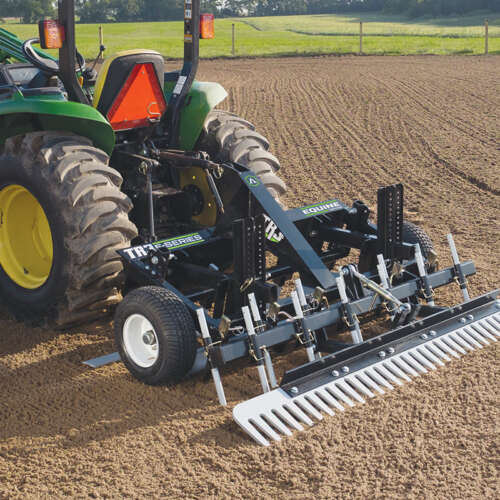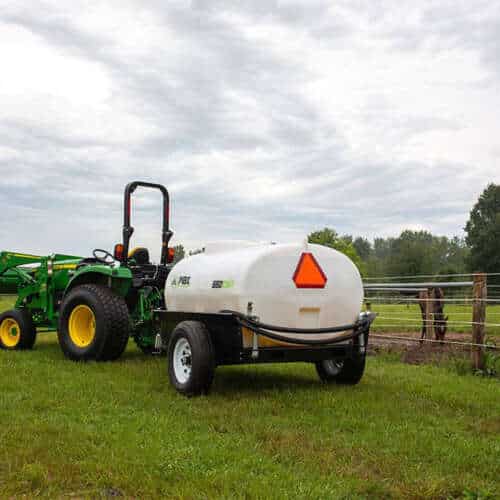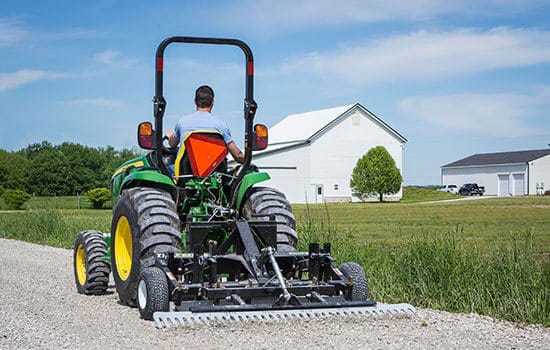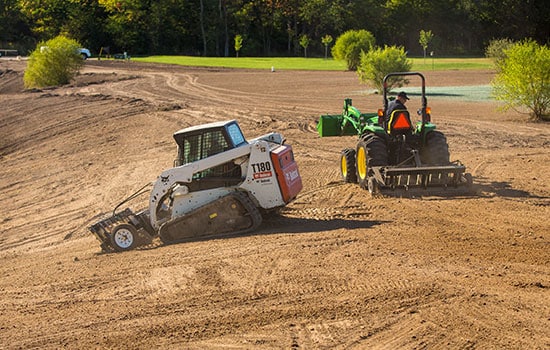Synthetic Arena Footing vs. Natural Arena Footing: What’s the Difference – ABI Dirt
Let’s talk about synthetic arena footing
If you ride on synthetic arena footing, you’ve added some synthetic additives to your dirt, or you’re thinking of converting from fully natural footing, this video is for you! In this episode, Matt checks in with Nate to learn more about the difference between natural and synthetic footing.
ABI Products Shown In This Video

TR3 “E” Equine Edition
- Starting At: $128/mo.*
- For Sub-Compact & Compact Tractors, #1 Selling Arena Drag
- 6', 7', 8' Widths

550 Gallon Compact Water Trailer
- Starting At: $195/mo.*
- Farm Use: Compact Tractor
- Min. Vehicle Weight: 2,400 lbs. On Flat Ground, Towing Capacity 5,200 lbs. On Uneven Terrain
Transcript
Matt: Hey everyone, Matt with ABI Attachments. Welcome back to the ABI Dirt. If you’ve been around the ABI Dirt for any amount of time, you know that we love talking about arena footing. That’s because we know that the quality of your arena footing, how well you maintain your arena footing, has a direct connection to the performance, longevity, and overall health of your horse. It actually helps your life quite a bit, as well.
But when we’ve been talking about footing, typically we’ve been talking about natural footing. And by natural, I mean the dirt that comes from the ground, the natural dirt, right? Sand, silt, and clay, any combination thereof. Whatever your preference or taste is. And because we’ve been talking about natural footing, those of you who ride on synthetic footing or have seen arenas with synthetic additives may have been feeling left out. But today we’re looking to change that.
Right now, our head engineer here at ABI Attachments and also often co-host here on the ABI Dirt, Nate Smith, is down visiting our longtime friend and brand ambassador Dan James on his farm in Kentucky. As you may know, Dan is both a reiner and Liberty competitor, which means he works on both synthetic and natural footing. How’s it going, Nate? What are you doing down there?
Nate: Hey Matt, we’re out here at Dan James’ horse farm, and we wanted to show you something about the material that he has in his arenas.
Matt: Dan James has been a friend of ABI for a long time now, and he is an incredible competitor, showman, trainer, and clinician. And fun fact, if you didn’t already know it, Dan also trains horses for both movies and TV. Nate, what kind of footing are you working with on Dan’s farm right now?
A Closer Look at Synthetic Footing
Nate: So what he has in this particular round pen and his arenas is what we refer to in the industry as synthetic footing. So this has fibers mixed with sand, and so there’ll be chunks of geotextile fabric, there’ll be cut up carpet, there’ll be all kinds of different things. Sometimes there’s even binders like waxes or a polymer coating on the sand. But what this is trying to duplicate is sod, or something way firmer than just like a sand clay arena.
What footing should you use for different riding disciplines?
Matt: So Nate, there’s often some confusion when it comes to kind of what disciplines people are training for and what footing is standard or should be used. And so, can you help us understand or elaborate a little bit, Nate, what are some common disciplines that train on synthetic arena footing?
Nate: So, synthetic footing has more grip, which is important for disciplines like jumping and dressage. And Dan James is a Western rider here, but he uses it for Liberty. He actually also has natural footing, ’cause he’s also a reiner, and synthetic is not appropriate for reining.
Synthetic Footing Arena Maintenance
Matt: Nate, all the time we’re getting questions to our customer service team about how to save a little bit of time, right? Because we all need more time in a day, and how much time it takes to take care of an arena is a common hot topic for us. So can you please talk us through what kind of maintenance needs are required in a synthetic arena?
Nate: So synthetic footing does still need to be groomed. It’s still gonna get displaced by the horses. It’s still gonna get compacted, and it’s also gonna need to be watered. There’s this popular misconception that synthetic arenas don’t need groomed or don’t need groomed but once a week or once a month. Now they typically need more than that, and unless you’re using some sort of other supplement, they’re gonna need watered as well. Because water many times is a binding agent in these arenas. In this particular round pen, we actually can show the effect of moisture. If I come out here to the middle and grab a handful, you’ll see how this clumps up. This could use a little more, but it’s still pretty clumpy, pretty solid, kind of breaks apart when I put my hand through it. But otherwise, it’ll form a solid chunk. If I come back here, to the edge where it didn’t get watered, where it’s dry, it just filters right through my fingers when I try to pinch it. This has no structure to it. So the water is the binding agent that gives the footing the structure.
Moisture Content for Synthetic Arenas
Matt: Now Nate, you and your team here at ABI are no strangers to watering systems. I know recently you guys just redesigned the compact water trailers here at ABI. So, thinking about water, thinking about moisture content that’s required in a synthetic arena, what are the differences and what kind of water systems are available or popular for synthetic arenas?
Nate: So synthetic has multiple different watering systems used. Some people use sprinklers, some people use water trailers, some people use underground water systems, which use way less water, but are a bigger upfront cost. So there are multiple ways of approaching watering an arena, but we don’t wanna downplay the fact that these arenas do generally take quite a bit of water.
Can You Use A Natural Footing Groomer on a Synthetic Arena?
Matt: So now Nate’s still thinking about, like on the vein of arena maintenance and taking care of the arena that you’ve got. Can people just take the natural arena footing or the natural footing arena groomers that are out there in the market or maybe that they’ve had around the property for years and use it in a synthetic arena?
Nate: When we’re referring to synthetic and we talk about fiber, there’ll be pieces of textile or fiber like this. It’s very important that these are mixed thoroughly into the footing, not just like, left and right, up and down, but also in the whole profile and the thickness of the material, the 2, 3, 4 inches deep. With the fiber and the textile in these arenas, the challenge is, is that’ll wrap around ground engaging components of natural footing drags. So to really get the optimal performance, to get the footing set, and leveled, and loosened, and compacted the way you’d want it, you really need to use a natural footing drag for natural footing, and a synthetic footing drag for synthetic. The materials are just very different.
Matt: Now, Nate, since Dan uses both synthetic arena footing and natural footing on his property in different arenas, would you mind giving us a glimpse at his natural footing arenas? And, while you’re at it, give us just a quick refresher on what disciplines typically use natural arena footing.
Natural Footing Overview and Riding Disciplines
Nate: So natural footing is composed of sand and clay, with no other fibers or other textiles or anything added to it. It’s more popular in the Western disciplines. You’re roping, your barrel riding, your other speed sports, reining. And the reason for that is, is that those horses many times are sliding, they’re getting deeper into the footing. One of the big contrasts is in natural footing, you’re using 2, 3, 4 inches of the profile of the arena, sometimes deeper in order for that horse to work in. Versus in these synthetic arenas, the horses are staying way more on top, and they’re working in the top inch or two inches.
Matt: Nate, thanks so much. Now let’s ask the previous question in reverse there. If I have a synthetic arena groomer, because I’ve been using synthetic arena footing for years, but I also have, you know, a new arena that I want natural footing in, can I just take my synthetic arena groomer and take it over to my natural footing?
Can You Use a Synthetic Groomer on a Natural Footing Arena?
Nate: If we were to take a synthetic drag that is designed to work just on the top and try to use it in an arena where you’re actually trying to work a whole soil profile, people aren’t gonna be satisfied with actually working the entire profile, because those drags inherent in their design is to stay on top and work just the top range of the profile. They struggle to decrease compaction all the way through. They generally don’t have things like profile blades that will reset and set false bases and other things that, depending upon the event, people will want to use. In your English disciplines, they’re generally sitting on top of the footing because they want a firm, firm foundation, versus the horse is punching through those in the Western disciplines and working in the soil profile more. So, because of that, drags that are designed for synthetic generally only work on the top, and won’t effectively de-compact the entire soil profile like a specific natural footing drag will.
Matt: So it sounds like with natural arena footing and synthetic arena footing, people are looking to accomplish different things. There’s different fields they want with it. But Nate, what if somebody has natural arena footing and they want to add some synthetic additives to it, because they want that extra grip, that extra purpose?
What if I’m Adding Synthetic Additives to a Natural Arena?
Nate: Yeah. Yeah. So, another common scenario is people will have a natural arena like this and they’ll want to add some fiber to it, or some additive to it. They want to give it more structure, they want to, they’re desiring a different result. And that’s very possible. And it’s possible that your natural footing drag will work, up to a certain percentage of that material before the material no longer flows through it.
Matt: Nate, thanks so much, man. We’ll let you get back to work there on Dan James’ farm. Make sure to say hi to Dan and give the kangaroo a high five for us. I hope that was informative, especially for those of you who have synthetic footing arenas or you have synthetic additives in your sand arenas. Sorry to make you feel left out for years. And you may be asking, “Why now, Matt? Why are you talking about the differences between natural and synthetic when ABI Attachments doesn’t even have a designated synthetic footing arena groomer?” Well, all I can tell you is, stay tuned. On next week’s episode of the ABI Dirt, we’ve got some pretty fun news for all of you. I am gonna make you wait until then. But let’s be honest, if you were to give us a phone call and ask to talk to one of our product specialists, those guys, they can’t keep secrets. So give us a call then if you have any questions about the synthetic footing in your arena. But until next time, have a great week.
For more information on these or other attachments visit us at abiattachments.com or call a Product Specialist at at 877.788.7253



